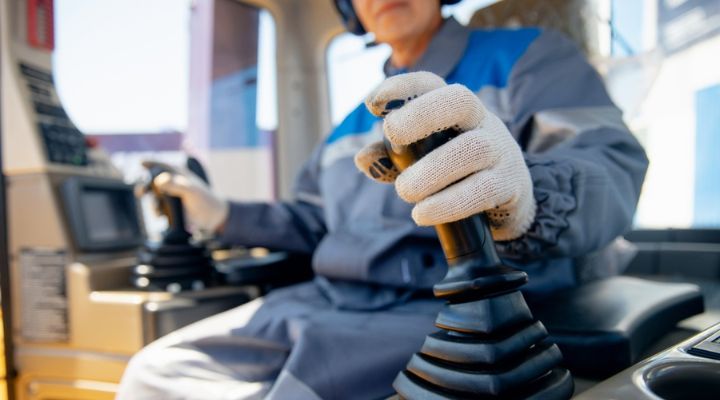
Cranes must be adequately serviced and inspected prior to use to prevent unexpected failure and personal injury. Cranes are designed for a specific purpose and must be maintained to perform the job they are designed to do, or they can become extremely dangerous.
Crane operators are highly trained in the use and operation of cranes, and are generally responsible for keeping them in safe, operable condition. Part of the training crane operators receive involves inspecting a crane before operating it.
Today, we will delve a little deeper into the processes that must be performed before operating a crane, and why they are necessary. These processes will involve performing safety checks of the crane, using safety gear, and reviewing the maintenance records.
Perform Safety Checks On the Crane
Statistically, most accidents resulting from crane use are the result of electrical hazards, overloading the crane, and mis-management of loads, particularly with overhead hoists. These situations can often be avoided with proper site inspection, load handling, and procedures.
Accidents still happen, but most can be avoided using procedures outlined by the manufacturer of the crane. Here is a partial list of the checks a crane operator must perform every time they operate any crane:
Check the Area Around the Crane
The first step of a crane inspection checklist should include first inspecting the area around the crane. Although the crane may be in perfectly operable condition, it can still be accidentally moved into a scissor lift or live electrical work being conducted nearby. Always know the operable range of the crane and note any potential obstacles.
Ensure Any and All Safety Guards Are In Place and Operational
Sometimes, there is a good reason to remove a safety guard, such as while the crane is being serviced. These situations require a “DO NOT OPERATE” tag, which indicates the crane is defective or under repair. These tags should only be removed by the technician that placed it, so these cranes should never be operated for any reason while the tag is in place.
Many cranes also have operation switch covers that lock, preventing unauthorized use of the crane. Some have detachable switch keys, while others require PIN codes to gain access to the crane controls. Regardless, these safety precautions should always be observed, and the crane should be considered a hazard if they are missing.
Inspect the Wire Rope, Chain, Block, Drum, and Hook
If the crane appears operational, the next step is to inspect the crane itself for any indications of wear or damage. Especially the moving parts of the crane, like the wire rope, chain, blocks, drum, and hook must be inspected before each use.
Unknown damage can occur between shifts, parts can break unusually fast, and loads can unexpectedly fall. Always conduct a walk around inspection of any crane and look for signs of premature failure, like stress cracks or deep scratches. Never operate a crane that fails any of these inspections, as they often indicate an imminent mechanical failure.
Inspect the Bumpers and Test the Switches
Many cranes, like overhead cranes and gantry cranes, use bumpers to absorb any excessive impact that might be absorbed by the trolly or bridge of the crane. These bumpers prevent two cranes from accidentally impacting each other, and serve as an emergency backup should a limit switch fail.
As such, these bumpers must be confirmed in place and functional before operating any crane that has them. Cranes can detach from the rail if one side has a functional bumper and the other doesn’t, so be sure and inspect both sides.
In addition to the bumpers, the limit switches that prevent the crane from traveling beyond a designated point must be checked for proper operation. These limit switches are tested to ensure that the crane is slowed down or stopped before it impacts an obstacle, or travels further than it should.
Be Sure to Use All Appropriate Safety Equipment
Anyone operating, or in the vicinity of an operating crane must wear the appropriate safety gear. Safety gear used around a crane should include:
Hardhat
In most situations, the hardhat to wear around a crane is a Type 2, Class E. A type 2 hardhat is designed to protect the head from directly falling objects as well as side and lateral impacts. Class E hardhats are designed to protect against electrical shock, up to 20,000 volts. Due to the nature of crane operation, such as using chains and wire ropes, type 2, class E hardhats offer the most overall protection. Using a Class E hardhat greatly reduces the risk of contacting an accidentally charged wire rope or chain, reducing electrocution accidents.
Adjust your hardhat to fit snugly, because a loose fitting hardhat may not absorb an impact as effectively. Always wear an OSHA approved hardhat on the job, as they have been tested and approved for a specific use.
Hard Toed Boots (Steel, Aluminum, or Composite Toed Boots)
As falling hazards are one of the most common causes of crane accidents, anyone near a crane should wear hard toed boots, which often have steel inserts over the toes and under them. More modern hard toe boot designs use aluminum instead of steel, as it is about 30% lighter. Composite hard toe boots serve the same function as well, but incorporate cutting edge materials like carbon fiber, kevlar, fiberglass, and plastics into the protected area.
Safety Glasses
Safety glasses are an essential piece of personal protective equipment (PPE) when working around a crane. Anyone working around a crane should wear the appropriate safety glasses or goggles for the task. For example, metal frame safety glasses should not be used when working around the electrical components of a crane, as the metal may serve as an electrical conductor.
Work Gloves
As with safety glasses, anyone working near a crane should wear appropriate gloves. Generally, medium to heavy leather gloves are common when working with or rigging a crane. Known as rigger gloves, these gloves are usually made from some sort of breathable fabric and include a leather palm and fingers. Rigger gloves are good for preventing scrapes and abrasions from moving cables and chains, and can serve as an electrical insulator .
Review the Maintenance Log Before Each Use
Maintenance logs are very important to the safe operation of any crane. Some cranes require more maintenance than others, but following the manufacturer’s maintenance schedule is critical to the life and performance of the crane. OSHA requires that any crane be inspected at least once every year, but some cranes perform functions that induce unusual wear. Often these cranes are fully inspected quarterly.
The maintenance log must be reviewed before the use of a crane, to include periodic lubrication and replacement of seals and gaskets. Full maintenance procedures are often reserved for slow manufacturing periods, or once yearly periodic shutdowns. However, deliberate, daily inspection of these components is important to reduce premature failures that can lead to accidents.
Frequently Asked Questions:
What Are the Most Common Hazards When Using a Crane?
Electrical Hazards
By far, electrical hazards are responsible for the majority of overhead crane accidents. Most of the time, the rigger and/or operator have encroached into an area known as the danger zone. OSHA defines the area within 10’ of a power source an unsafe work area in an effort to reduce accidental electrocutions. In most cases, the crane body or suspension system comes into contact with the power source, electrocuting the crane and anyone touching it.
Overloading the Capacity Of the Crane
Osha statistics claim that 80% of crane upsets and mechanical failure are the direct result of overloading the lifting capacity of the crane. Crane operators are generally responsible for overseeing the activities of riggers and other helpers, and are responsible for final inspection. The role of the operator includes a thorough study of the load capacities and capabilities of the crane. If the operator fails to adhere to these limitations, the result can be catastrophic.
Mis-Handling Of Loads
Improper load rigging and lack of backup precautions can result in property damage, personal injury, and death. Loads can shift, components can fail, and improper rigging can all result in dangerous situations that can be avoided. Load capacities and specifications of every crane are clearly labeled and visible on the crane itself. Often, a simple checklist or buddy check system will prevent casual mistakes that can lead to a disaster.
Why Should You Remove All Loads From a Crane When It Is Not In Use?
Cranes under load should be considered a safety hazard, whether they are operating or not. All safety procedures used when operating the crane under normal use should be followed until the load is resting on the floor and any loads acting on the crane have been removed. Loads should never be suspended unattended until a safety process has performed.
Always Operate the Crane Safely
Inspecting the crane, using the appropriate safety gear, and proper maintenance can prevent most crane accidents and premature failures. A crane operator should always be aware of the surroundings, and be wearing head, eye, feet and hand protection. Following proper start up procedures can keep the crane, the space, and the operator as safe as possible. Request a professional crane inspection here.




